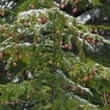Background
- Eastern hemlock contains tannins (organic compounds), which are responsible for some of its medicinal properties. The bark has astringent properties, and the leaves contain significant amounts of vitamin C.
- Traditionally, Eastern hemlock was used to treat digestive disorders, mouth/throat disorders, and diarrhea.
- Although the Eastern hemlock is primarily used for lumber today, Native Americans used the tree's cambium (the tissue in a plant that produces new cells) in breads, soups and pemmican (dried, pounded meat mixed with fat and berries). Early settlers also used the tree in dying wool and tanning leather.
References
Natural Standard developed the above evidence-based information based on a thorough systematic review of the available scientific articles. For comprehensive information about alternative and complementary therapies on the professional level, go to . Selected references are listed below.
- Broeckling CD, Salom SM. Volatile emissions of eastern hemlock, Tsuga canadensis, and the influence of hemlock woolly adelgid. Phytochemistry 2003;62(2):175-180.
View Abstract - Feucht W, Treutter D, Polster J. Flavanol binding of nuclei from tree species. Plant Cell Rep. 2004;22(6):430-436.
View Abstract - Forest Service. Eastern Hemlock. American Woods--FS-239 1970.
- Mitchell, J. C. Patch test results - screening set and plants. Contact Dermatitis Newsletter 1970;8:177.







